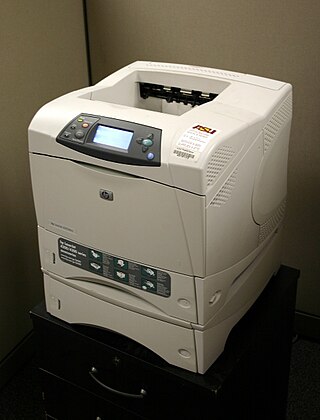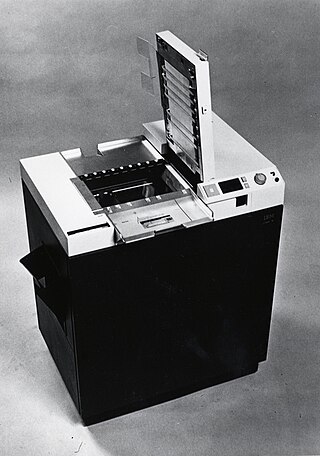
The IBM 3270 is a family of block oriented display and printer computer terminals introduced by IBM in 1971 and normally used to communicate with IBM mainframes. The 3270 was the successor to the IBM 2260 display terminal. Due to the text color on the original models, these terminals are informally known as green screen terminals. Unlike a character-oriented terminal, the 3270 minimizes the number of I/O interrupts required by transferring large blocks of data known as data streams, and uses a high speed proprietary communications interface, using coaxial cable.

Laser printing is an electrostatic digital printing process. It produces high-quality text and graphics by repeatedly passing a laser beam back and forth over a negatively charged cylinder called a "drum" to define a differentially charged image. The drum then selectively collects electrically charged powdered ink (toner), and transfers the image to paper, which is then heated to permanently fuse the text, imagery, or both, to the paper. As with digital photocopiers, laser printers employ a xerographic printing process. Laser printing differs from traditional xerography as implemented in analog photocopiers in that in the latter, the image is formed by reflecting light off an existing document onto the exposed drum.
Systems Network Architecture (SNA) is IBM's proprietary networking architecture, created in 1974. It is a complete protocol stack for interconnecting computers and their resources. SNA describes formats and protocols but, in itself, is not a piece of software. The implementation of SNA takes the form of various communications packages, most notably Virtual Telecommunications Access Method (VTAM), the mainframe software package for SNA communications.

Daisy wheel printing is an impact printing technology invented in 1970 by Andrew Gabor at Diablo Data Systems. It uses interchangeable pre-formed type elements, each with typically 96 glyphs, to generate high-quality output comparable to premium typewriters such as the IBM Selectric, but two to three times faster. Daisy wheel printing was used in electronic typewriters, word processors and computers from 1972. The daisy wheel is so named because of its resemblance to the daisy flower.

LaserJet as a brand name identifies the line of laser printers marketed by the American computer company Hewlett-Packard (HP). The HP LaserJet was the world's first commercially successful laser printer. Canon supplies both mechanisms and cartridges for most HP laser printers; some larger A3 models use Samsung print engines.

The IBM 2250 Graphics Display Unit was a vector graphics display system by IBM for the System/360; the Model IV attached to the IBM 1130.

OS/6 is a standalone word processor made by IBM's Office Products Division (OPD), introduced in January, 1977. OS/6 was superseded by the IBM Displaywriter in 1980.

IBM manufactured and sold document processing equipment such as proof machines, inscribers and document reader/sorters for financial institutions from 1934 to 2005.

The IBM 6580 Displaywriter System is a 16-bit microcomputer that was marketed and sold by IBM's Office Products Division primarily as a word processor. Announced on June 17, 1980 and effectively withdrawn from marketing on July 2, 1986, the system was sold with a 5 MHz Intel 8086, 128 KB to 448 KB of RAM, a swivel-mounted monochrome CRT monitor, a detached keyboard, a detached 8" floppy disk drive enclosure with one or two drives, and a detached daisy wheel printer, or Selectric typewriter printer. The primary operating system for the Displaywriter is IBM's internally developed word processing software titled "Textpack", but UCSD p-System, CP/M-86, and MS-DOS were also offered by IBM, Digital Research, and CompuSystems, respectively.
The IBM 2780 and the IBM 3780 are devices developed by IBM for performing remote job entry (RJE) and other batch functions over telephone lines; they communicate with the mainframe via Binary Synchronous Communications and replaced older terminals using synchronous transmit-receive (STR). In addition, IBM has developed workstation programs for the 1130, 360/20, 2922, System/360 other than 360/20, System/370 and System/3.

The IBM Selectric was a highly successful line of electric typewriters introduced by IBM on 31 July 1961.

The IBM 6640 printer was one of the world's first office ink jet printers. It was originally announced as the 46/40 but later renamed as 6640, as part of the Office System/6 word processing range in 1976.
The IBM 5520Administrative System was a text, electronic document‐distribution and data processing system, announced by IBM General Systems Division (GSD) in 1979.

The IBM 3800 is a discontinued laser printer designed and manufactured by IBM. It was the first commercially available laser printer. It was a continuous form laser printer, meaning that it printed onto a continuous long sheet of paper.

IBM Office Products Division (OPD) manufactured and sold copier equipment and supplies from 1970 till IBM withdrew from the copier market in 1988. IBM's decision to compete in this market resulted in the first commercial use of an organic photoconductor now widely used in most photocopiers. It is often held up as an example of a corporate u-turn, where a company rejects a technology and then adopts it. It showed that despite the size of IBM's sales and engineering organisations, this did not guarantee success in every market it chose to compete in. The development effort that resulted in the IBM Copier helped in the development of IBMs first laser printer, the IBM 3800.`

The Honeywell Page Printing System (PPS) announced in 1974, is notable because it was the first commercially successful high speed non-impact printer. It could produce output at up to 18,000 lines per minute, where the earlier Xerox 1200 ran at 4000 lines per minute and the contemporary IBM 3211, ran at 2000 lines per minute. Most printer history has focused on the later IBM 3800 and the Xerox 9700.

The Xerox 1200 Computer Printing System is a computer printer system that was developed by Xerox. It was the first commercial non-impact Xerographic printer used to create computer output. It is sometimes mistakenly referred to as a laser printer, but it did not in fact have a laser.

IBM manufactured and sold microfilm products from 1963 till 1969. It is an example of IBM attempting to enter an established market on the basis of a significant technical breakthrough.

IBM designed, manufactured and sold optical mark and character readers from 1960 until 1984. The IBM 1287 is notable as being the first commercially sold scanner capable of reading handwritten numbers.














